A duplicated network structure for an LTE-Based train control communication
The International Union of Railways has decided to migrate railway communication technology
from being GSM-based to LTE-based or LTE-R. As a leading country in LTE space, South Korea will launch
the train control system based on LTE by 2016. To ensure the most reliable train operation in this system,
a fully duplicated network structure with overlaid radio cells is needed. Existing methods and results often
rely on a single network structure setup. Thus, in this paper, we introduce the design of an LTE-R train
control communication with a duplicated network structure. We propose two different network structures
with fully-overlapping cell arrangement and with partly overlapping cell arrangement, respectively for the
system and discuss major problems, including handover and inter-cell interference.
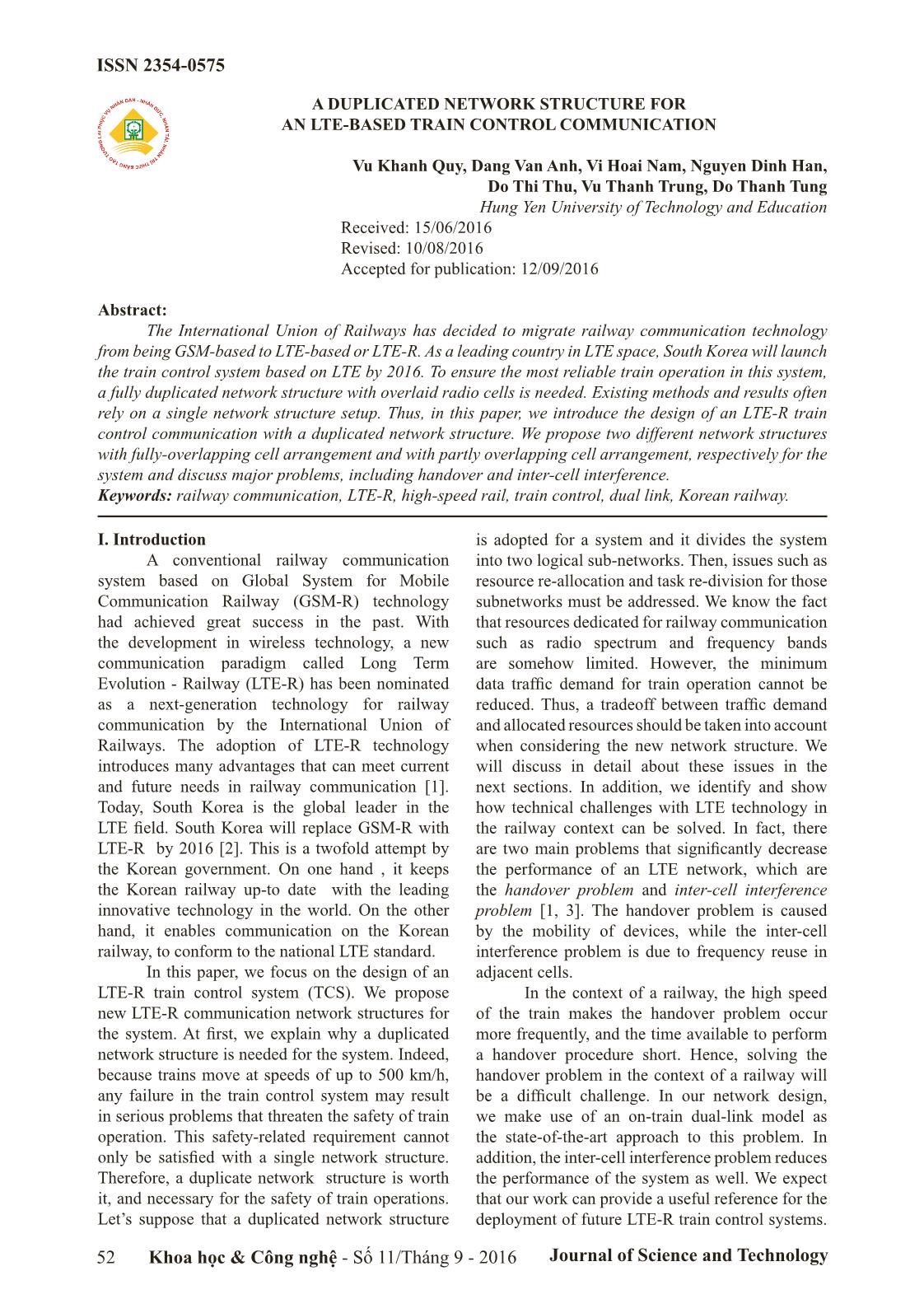
Trang 1
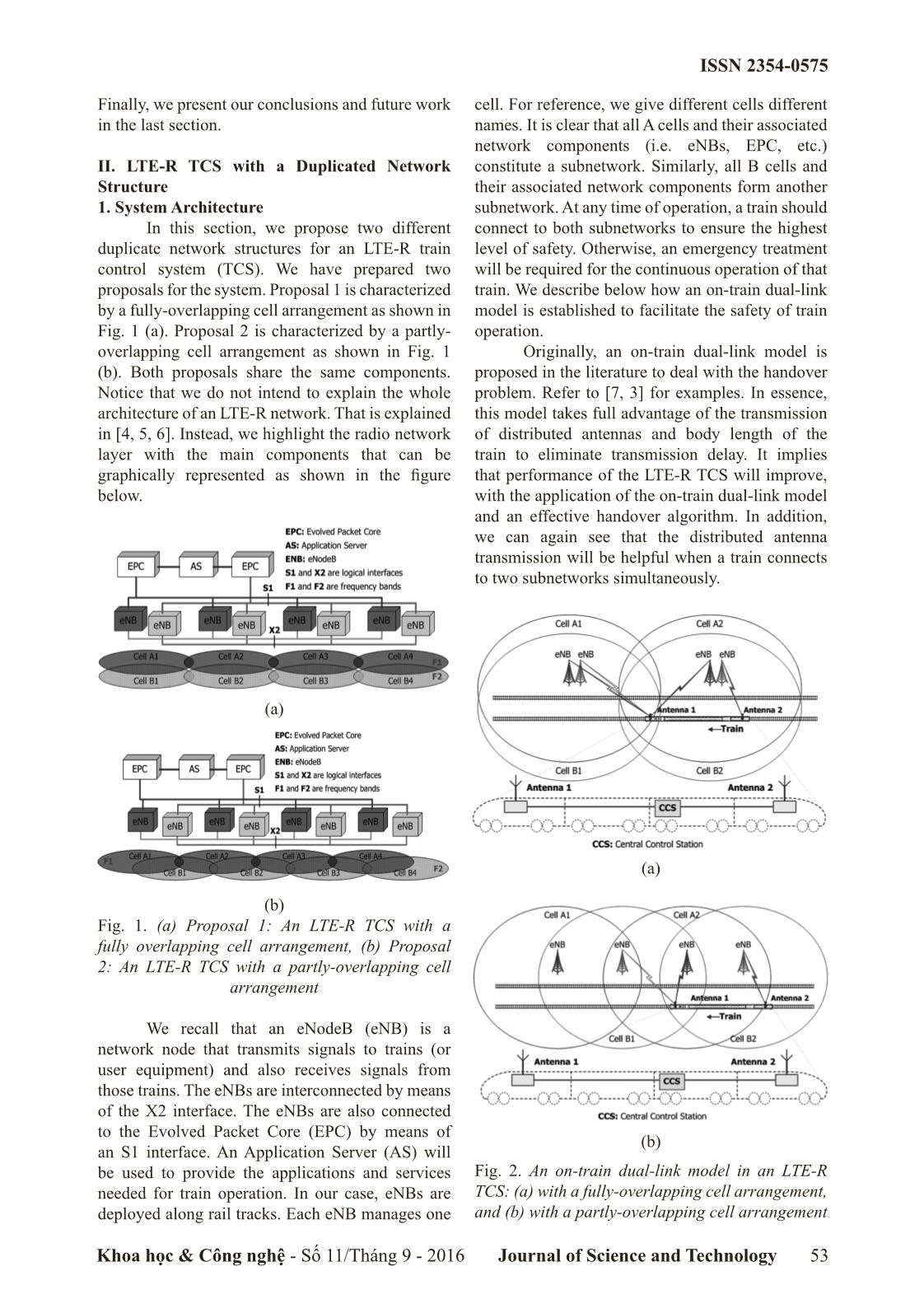
Trang 2
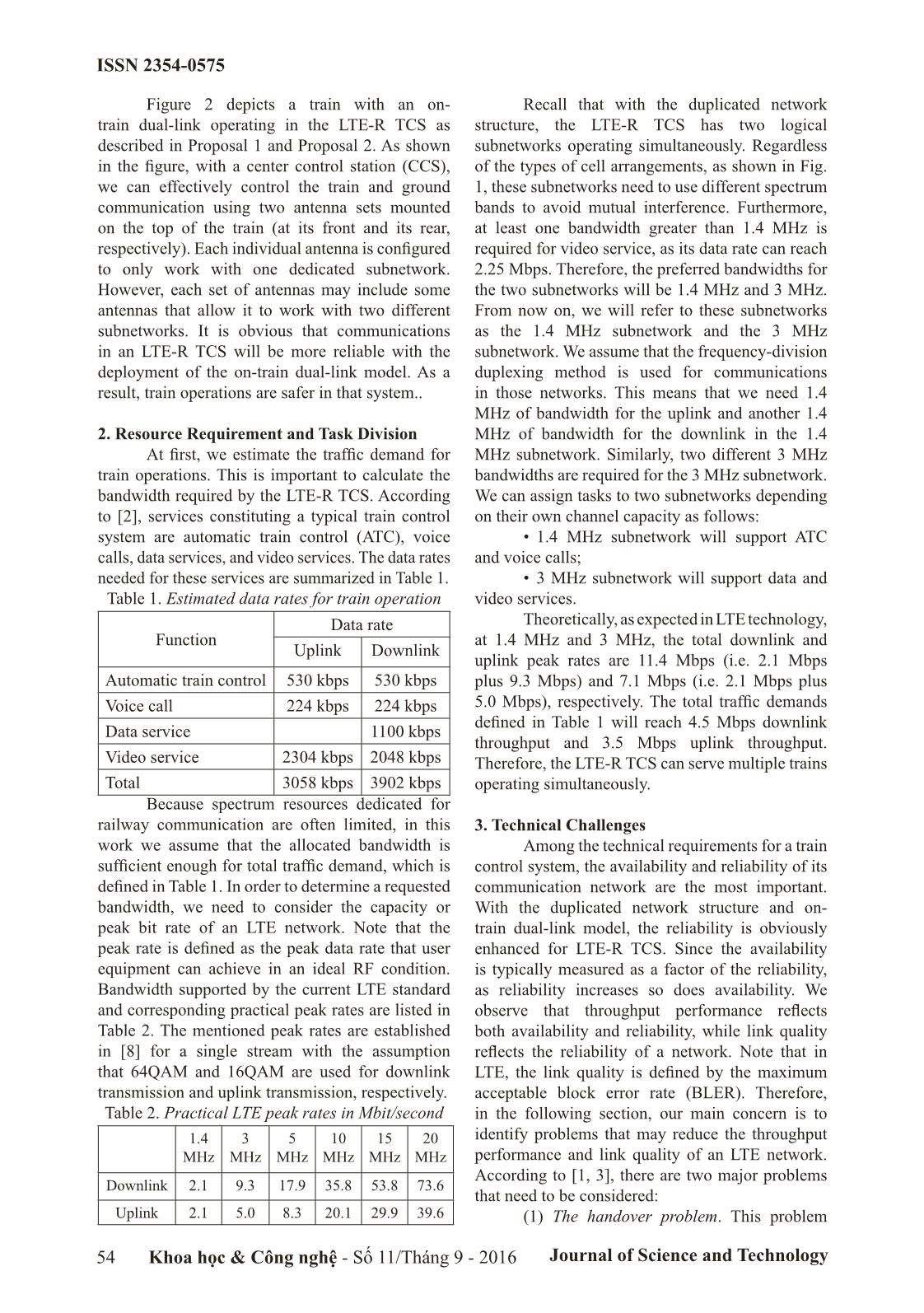
Trang 3
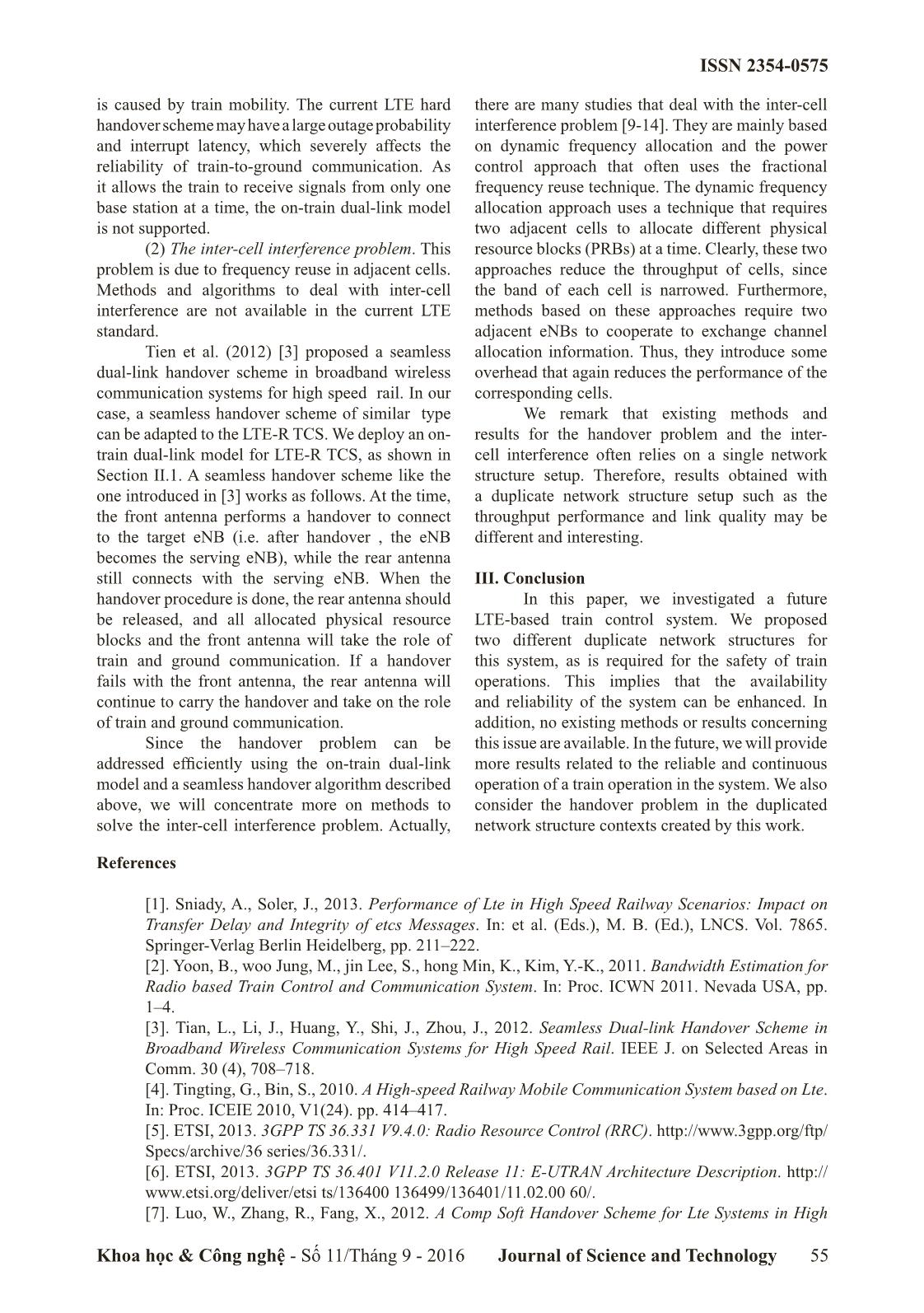
Trang 4
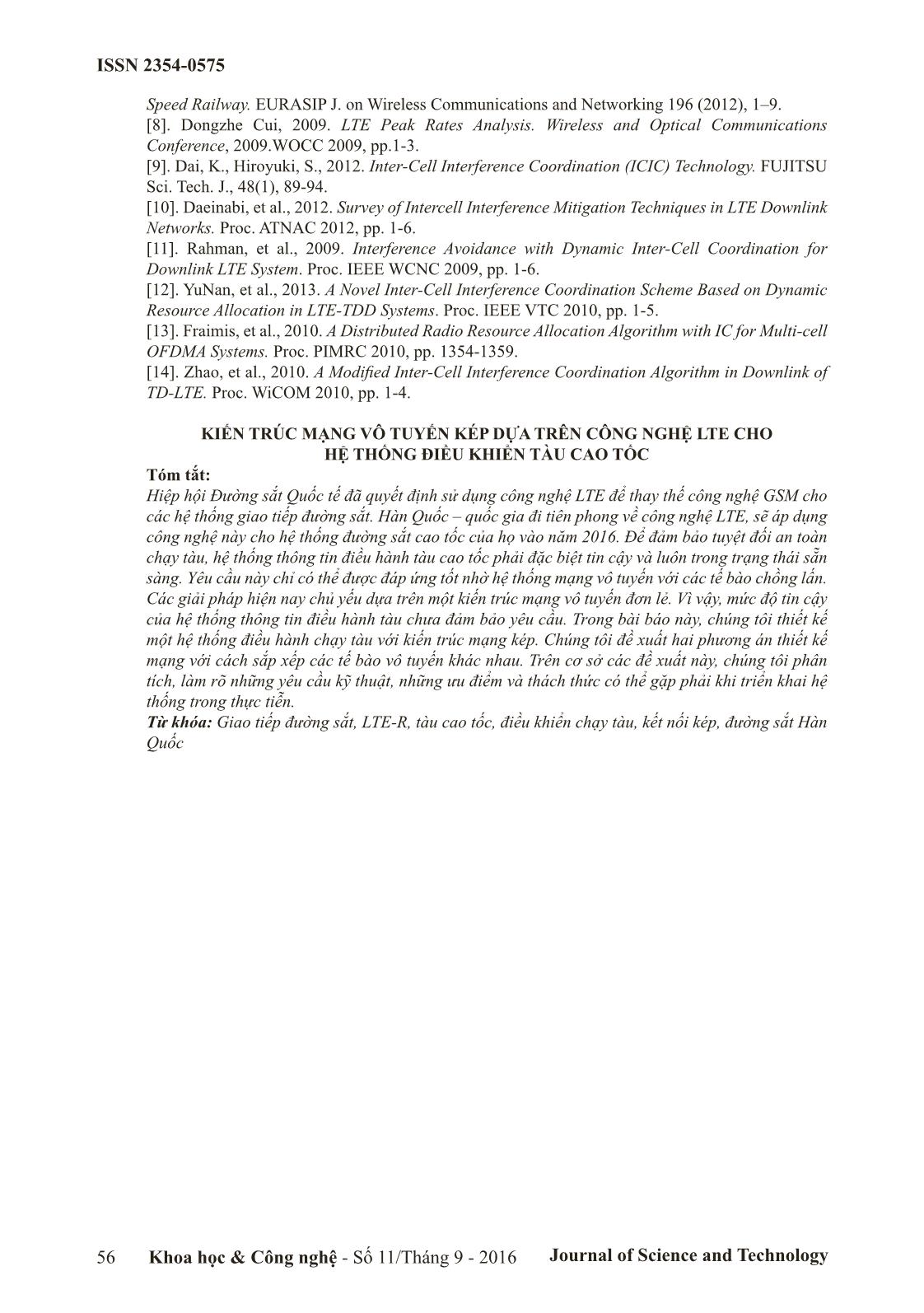
Trang 5
Tóm tắt nội dung tài liệu: A duplicated network structure for an LTE-Based train control communication
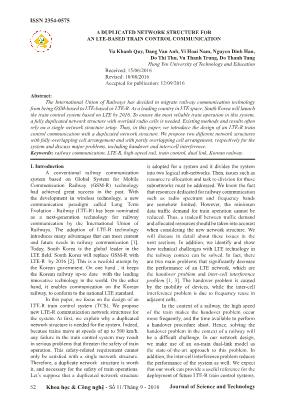
ng 9 - 2016 Journal of Science and Technology ISSN 2354-0575 Finally, we present our conclusions and future work cell. For reference, we give different cells different in the last section. names. It is clear that all A cells and their associated network components (i.e. eNBs, EPC, etc.) II. LTE-R TCS with a Duplicated Network constitute a subnetwork. Similarly, all B cells and Structure their associated network components form another 1. System Architecture subnetwork. At any time of operation, a train should In this section, we propose two different connect to both subnetworks to ensure the highest duplicate network structures for an LTE-R train level of safety. Otherwise, an emergency treatment control system (TCS). We have prepared two will be required for the continuous operation of that proposals for the system. Proposal 1 is characterized train. We describe below how an on-train dual-link by a fully-overlapping cell arrangement as shown in model is established to facilitate the safety of train Fig. 1 (a). Proposal 2 is characterized by a partly- operation. overlapping cell arrangement as shown in Fig. 1 Originally, an on-train dual-link model is (b). Both proposals share the same components. proposed in the literature to deal with the handover Notice that we do not intend to explain the whole problem. Refer to [7, 3] for examples. In essence, architecture of an LTE-R network. That is explained this model takes full advantage of the transmission in [4, 5, 6]. Instead, we highlight the radio network of distributed antennas and body length of the layer with the main components that can be train to eliminate transmission delay. It implies graphically represented as shown in the figure that performance of the LTE-R TCS will improve, below. with the application of the on-train dual-link model and an effective handover algorithm. In addition, we can again see that the distributed antenna transmission will be helpful when a train connects to two subnetworks simultaneously. (a) (a) (b) Fig. 1. (a) Proposal 1: An LTE-R TCS with a fully overlapping cell arrangement, (b) Proposal 2: An LTE-R TCS with a partly-overlapping cell arrangement We recall that an eNodeB (eNB) is a network node that transmits signals to trains (or user equipment) and also receives signals from those trains. The eNBs are interconnected by means of the X2 interface. The eNBs are also connected to the Evolved Packet Core (EPC) by means of (b) an S1 interface. An Application Server (AS) will be used to provide the applications and services Fig. 2. An on-train dual-link model in an LTE-R needed for train operation. In our case, eNBs are TCS: (a) with a fully-overlapping cell arrangement, deployed along rail tracks. Each eNB manages one and (b) with a partly-overlapping cell arrangement Khoa học & Công nghệ - Số 11/Tháng 9 - 2016 Journal of Science and Technology 53 ISSN 2354-0575 Figure 2 depicts a train with an on- Recall that with the duplicated network train dual-link operating in the LTE-R TCS as structure, the LTE-R TCS has two logical described in Proposal 1 and Proposal 2. As shown subnetworks operating simultaneously. Regardless in the figure, with a center control station (CCS), of the types of cell arrangements, as shown in Fig. we can effectively control the train and ground 1, these subnetworks need to use different spectrum communication using two antenna sets mounted bands to avoid mutual interference. Furthermore, on the top of the train (at its front and its rear, at least one bandwidth greater than 1.4 MHz is respectively). Each individual antenna is configured required for video service, as its data rate can reach to only work with one dedicated subnetwork. 2.25 Mbps. Therefore, the preferred bandwidths for However, each set of antennas may include some the two subnetworks will be 1.4 MHz and 3 MHz. antennas that allow it to work with two different From now on, we will refer to these subnetworks subnetworks. It is obvious that communications as the 1.4 MHz subnetwork and the 3 MHz in an LTE-R TCS will be more reliable with the subnetwork. We assume that the frequency-division deployment of the on-train dual-link model. As a duplexing method is used for communications result, train operations are safer in that system.. in those networks. This means that we need 1.4 MHz of bandwidth for the uplink and another 1.4 2. Resource Requirement and Task Division MHz of bandwidth for the downlink in the 1.4 At first, we estimate the traffic demand for MHz subnetwork. Similarly, two different 3 MHz train operations. This is important to calculate the bandwidths are required for the 3 MHz subnetwork. bandwidth required by the LTE-R TCS. According We can assign tasks to two subnetworks depending to [2], services constituting a typical train control on their own channel capacity as follows: system are automatic train control (ATC), voice • 1.4 MHz subnetwork will support ATC calls, data services, and video services. The data rates and voice calls; needed for these services are summarized in Table 1. • 3 MHz subnetwork will support data and Table 1. Estimated data rates for train operation video services. Data rate Theoretically, as expected in LTE technology, Function at 1.4 MHz and 3 MHz, the total downlink and Uplink Downlink uplink peak rates are 11.4 Mbps (i.e. 2.1 Mbps Automatic train control 530 kbps 530 kbps plus 9.3 Mbps) and 7.1 Mbps (i.e. 2.1 Mbps plus Voice call 224 kbps 224 kbps 5.0 Mbps), respectively. The total traffic demands defined in Table 1 will reach 4.5 Mbps downlink Data service 1100 kbps throughput and 3.5 Mbps uplink throughput. Video service 2304 kbps 2048 kbps Therefore, the LTE-R TCS can serve multiple trains Total 3058 kbps 3902 kbps operating simultaneously. Because spectrum resources dedicated for railway communication are often limited, in this 3. Technical Challenges work we assume that the allocated bandwidth is Among the technical requirements for a train sufficient enough for total traffic demand, which is control system, the availability and reliability of its defined in Table 1. In order to determine a requested communication network are the most important. bandwidth, we need to consider the capacity or With the duplicated network structure and on- peak bit rate of an LTE network. Note that the train dual-link model, the reliability is obviously peak rate is defined as the peak data rate that user enhanced for LTE-R TCS. Since the availability equipment can achieve in an ideal RF condition. is typically measured as a factor of the reliability, Bandwidth supported by the current LTE standard as reliability increases so does availability. We and corresponding practical peak rates are listed in observe that throughput performance reflects Table 2. The mentioned peak rates are established both availability and reliability, while link quality in [8] for a single stream with the assumption reflects the reliability of a network. Note that in that 64QAM and 16QAM are used for downlink LTE, the link quality is defined by the maximum transmission and uplink transmission, respectively. acceptable block error rate (BLER). Therefore, Table 2. Practical LTE peak rates in Mbit/second in the following section, our main concern is to 1.4 3 5 10 15 20 identify problems that may reduce the throughput MHz MHz MHz MHz MHz MHz performance and link quality of an LTE network. According to [1, 3], there are two major problems Downlink 2.1 9.3 17.9 35.8 53.8 73.6 that need to be considered: Uplink 2.1 5.0 8.3 20.1 29.9 39.6 (1) The handover problem. This problem 54 Khoa học & Công nghệ - Số 11/Tháng 9 - 2016 Journal of Science and Technology ISSN 2354-0575 is caused by train mobility. The current LTE hard there are many studies that deal with the inter-cell handover scheme may have a large outage probability interference problem [9-14]. They are mainly based and interrupt latency, which severely affects the on dynamic frequency allocation and the power reliability of train-to-ground communication. As control approach that often uses the fractional it allows the train to receive signals from only one frequency reuse technique. The dynamic frequency base station at a time, the on-train dual-link model allocation approach uses a technique that requires is not supported. two adjacent cells to allocate different physical (2) The inter-cell interference problem. This resource blocks (PRBs) at a time. Clearly, these two problem is due to frequency reuse in adjacent cells. approaches reduce the throughput of cells, since Methods and algorithms to deal with inter-cell the band of each cell is narrowed. Furthermore, interference are not available in the current LTE methods based on these approaches require two standard. adjacent eNBs to cooperate to exchange channel Tien et al. (2012) [3] proposed a seamless allocation information. Thus, they introduce some dual-link handover scheme in broadband wireless overhead that again reduces the performance of the communication systems for high speed rail. In our corresponding cells. case, a seamless handover scheme of similar type We remark that existing methods and can be adapted to the LTE-R TCS. We deploy an on- results for the handover problem and the inter- train dual-link model for LTE-R TCS, as shown in cell interference often relies on a single network Section II.1. A seamless handover scheme like the structure setup. Therefore, results obtained with one introduced in [3] works as follows. At the time, a duplicate network structure setup such as the the front antenna performs a handover to connect throughput performance and link quality may be to the target eNB (i.e. after handover , the eNB different and interesting. becomes the serving eNB), while the rear antenna still connects with the serving eNB. When the III. Conclusion handover procedure is done, the rear antenna should In this paper, we investigated a future be released, and all allocated physical resource LTE-based train control system. We proposed blocks and the front antenna will take the role of two different duplicate network structures for train and ground communication. If a handover this system, as is required for the safety of train fails with the front antenna, the rear antenna will operations. This implies that the availability continue to carry the handover and take on the role and reliability of the system can be enhanced. In of train and ground communication. addition, no existing methods or results concerning Since the handover problem can be this issue are available. In the future, we will provide addressed efficiently using the on-train dual-link more results related to the reliable and continuous model and a seamless handover algorithm described operation of a train operation in the system. We also above, we will concentrate more on methods to consider the handover problem in the duplicated solve the inter-cell interference problem. Actually, network structure contexts created by this work. References [1]. Sniady, A., Soler, J., 2013. Performance of Lte in High Speed Railway Scenarios: Impact on Transfer Delay and Integrity of etcs Messages. In: et al. (Eds.), M. B. (Ed.), LNCS. Vol. 7865. Springer-Verlag Berlin Heidelberg, pp. 211–222. [2]. Yoon, B., woo Jung, M., jin Lee, S., hong Min, K., Kim, Y.-K., 2011. Bandwidth Estimation for Radio based Train Control and Communication System. In: Proc. ICWN 2011. Nevada USA, pp. 1–4. [3]. Tian, L., Li, J., Huang, Y., Shi, J., Zhou, J., 2012. Seamless Dual-link Handover Scheme in Broadband Wireless Communication Systems for High Speed Rail. IEEE J. on Selected Areas in Comm. 30 (4), 708–718. [4]. Tingting, G., Bin, S., 2010. A High-speed Railway Mobile Communication System based on Lte. In: Proc. ICEIE 2010, V1(24). pp. 414–417. [5]. ETSI, 2013. 3GPP TS 36.331 V9.4.0: Radio Resource Control (RRC). Specs/archive/36 series/36.331/. [6]. ETSI, 2013. 3GPP TS 36.401 V11.2.0 Release 11: E-UTRAN Architecture Description. http:// www.etsi.org/deliver/etsi ts/136400 136499/136401/11.02.00 60/. [7]. Luo, W., Zhang, R., Fang, X., 2012. A Comp Soft Handover Scheme for Lte Systems in High Khoa học & Công nghệ - Số 11/Tháng 9 - 2016 Journal of Science and Technology 55 ISSN 2354-0575 Speed Railway. EURASIP J. on Wireless Communications and Networking 196 (2012), 1–9. [8]. Dongzhe Cui, 2009. LTE Peak Rates Analysis. Wireless and Optical Communications Conference, 2009.WOCC 2009, pp.1-3. [9]. Dai, K., Hiroyuki, S., 2012. Inter-Cell Interference Coordination (ICIC) Technology. FUJITSU Sci. Tech. J., 48(1), 89-94. [10]. Daeinabi, et al., 2012. Survey of Intercell Interference Mitigation Techniques in LTE Downlink Networks. Proc. ATNAC 2012, pp. 1-6. [11]. Rahman, et al., 2009. Interference Avoidance with Dynamic Inter-Cell Coordination for Downlink LTE System. Proc. IEEE WCNC 2009, pp. 1-6. [12]. YuNan, et al., 2013. A Novel Inter-Cell Interference Coordination Scheme Based on Dynamic Resource Allocation in LTE-TDD Systems. Proc. IEEE VTC 2010, pp. 1-5. [13]. Fraimis, et al., 2010. A Distributed Radio Resource Allocation Algorithm with IC for Multi-cell OFDMA Systems. Proc. PIMRC 2010, pp. 1354-1359. [14]. Zhao, et al., 2010. A Modified Inter-Cell Interference Coordination Algorithm in Downlink of TD-LTE. Proc. WiCOM 2010, pp. 1-4. KIẾN TRÚC MẠNG VÔ TUYẾN KÉP DỰA TRÊN CÔNG NGHỆ LTE CHO HỆ THỐNG ĐIỀU KHIỂN TÀU CAO TỐC Tóm tắt: Hiệp hội Đường sắt Quốc tế đã quyết định sử dụng công nghệ LTE để thay thế công nghệ GSM cho các hệ thống giao tiếp đường sắt. Hàn Quốc – quốc gia đi tiên phong về công nghệ LTE, sẽ áp dụng công nghệ này cho hệ thống đường sắt cao tốc của họ vào năm 2016. Để đảm bảo tuyệt đối an toàn chạy tàu, hệ thống thông tin điều hành tàu cao tốc phải đặc biệt tin cậy và luôn trong trạng thái sẵn sàng. Yêu cầu này chỉ có thể được đáp ứng tốt nhờ hệ thống mạng vô tuyến với các tế bào chồng lấn. Các giải pháp hiện nay chủ yếu dựa trên một kiến trúc mạng vô tuyến đơn lẻ. Vì vậy, mức độ tin cậy của hệ thống thông tin điều hành tàu chưa đảm bảo yêu cầu. Trong bài báo này, chúng tôi thiết kế một hệ thống điều hành chạy tàu với kiến trúc mạng kép. Chúng tôi đề xuất hai phương án thiết kế mạng với cách sắp xếp các tế bào vô tuyến khác nhau. Trên cơ sở các đề xuất này, chúng tôi phân tích, làm rõ những yêu cầu kỹ thuật, những ưu điểm và thách thức có thể gặp phải khi triển khai hệ thống trong thực tiễn. Từ khóa: Giao tiếp đường sắt, LTE-R, tàu cao tốc, điều khiển chạy tàu, kết nối kép, đường sắt Hàn Quốc 56 Khoa học & Công nghệ - Số 11/Tháng 9 - 2016 Journal of Science and Technology
File đính kèm:
 a_duplicated_network_structure_for_an_lte_based_train_contro.pdf
a_duplicated_network_structure_for_an_lte_based_train_contro.pdf

